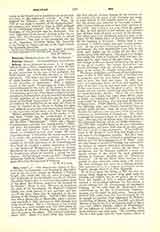

Bec, Abbey of.—The Benedictine Abbey of Bec, or Le Bec, in Normandy, was founded in the earlier part of the eleventh century by Herluin, a Norman knight, who about 1031 left the court of Count Gilbert of Brionne to devote himself to a life of religion. The abbey itself is now in ruins, but the modern name of the place, Bec-Helloin, preserves the memory of its founder. There is some difference in reckoning the date of the foundation, for Herluin’s religious family was twice moved to new quarters, and any one of the three dates may be regarded as the beginning of the famous abbey. Herluin’s first foundation was at Bonneville, or Burneville, where a monastery was built in 1034, and here in 1037, Herluin was consecrated abbot, But in a few years it was decided to move to a more suitable site, two miles away, by the banks of the Bec (Danish, Bcek, a brook) which gave its name to the abbey. This removal took place about 1040. About two years after this, Lanfranc, who had already become famous for his lectures at Avranches, left the scene of his triumphs and came to bury himself in this humble home of piety. At, first his retreat was unknown to the world without, while his new brethren seem to have been unaware of his worth. But within a few years from his arrival at Bee, he had opened a new school, and scholars were flocking from all parts to listen to his lectures. The abbey grew and prospered, and the good work begun by the simple piety of Herluin was crowned by the learning of Lanfranc. Before long it was necessary to build a larger and more lasting monastery. As the site first chosen had proved to be unsatisfactory, the new foundations were laid in another spot, higher up the valley of the Bec and further away from the water. This important change was really the work of Lanfranc, who was now the prior and the right hand of the aged abbot. As the first change of site was closely followed by the arrival of one great teacher, this second foundation was almost coincident with the coming of a yet greater glory of the abbey, St. Anselm of Canterbury.
The future archbishop and Doctor of the Church first came to Bec in 1060 while the work of building was in progress, and the year before the monks were able to move into their new home. In 1062, Lan-franc was appointed Abbot of Caen, and Anselm, in spite of the fact that he had been such a short time at Bec, was chosen to take his place as prior. In the school also the famous master was succeeded by his yet more illustrious disciple. When the new abbey church at Bec, which had taken some fifteen years to build, was finished in 1077, it was appropriately consecrated by Lanfranc who was now Archbishop of Canterbury. Abbot Herluin, the founder, died in the following year, and Anselm succeeded him as second Abbot of Bee. Only six years later Abbot Anselm was called to take the place of his old master, Lanfranc, as Archbishop of Canterbury. The abbey continued in existence down to the French Revolution. The long list of abbots from the eleventh to the eighteenth century, given in “Gallia Christiana” (XI, 222-239), contains many of the most illustrious French names, and shows that even in its later years Bec was a place of some importance. It had suffered much in the Hundred Years War with England, and still more in the Huguenot troubles. But after these days of desolation it was restored to something of its former state by the Congregation of St. Maur. Thus the chief house of medieval learning was renewed by the fathers of modern historical scholarship. This restoration was too soon undone by the forces of revolution; but the Maurists rendered a more enduring service to the abbey by their admirable editions of Lanfranc, Anselm, and the “Chronicon Beccense”. Of the old abbey whose erection is recorded in that chronicle, some ruins still remain. The later buildings now serve as a military station. This transformation is a curious counterpart to the happier change effected at Fort Augustus.
In its later years the Abbey of Bec was but one among many religious houses doing good work for learning and religion, but in the golden age of Lan-franc and Anselm it held a unique position, and exerted a far-reaching influence on the course of church history and the advancement of theological learning. In its early days the abbey gave three archbishops to the See of Canterbury: Lanfranc, Anselm, and Theobald the fifth abbot. Among other prelates who came from this famous school it will be enough to mention Pope Alexander II, William, Archbishop of Rouen, Arnost, Gundulf. and Ernulf, Bishops of Rochester, No of Chartres, Fulk of Beauvais, and Gilbert Crispin, Abbot of Westminster. Of the influence of Lanfranc‘s work at Bec John Richard Green says very truly: “His teaching raised Bec in a few years into the most famous school of Christendom. It was in fact the first wave of the intellectual movement which was spreading from Italy to the ruder countries of the West. The whole mental activity of the time seemed concentrated in the group of scholars who gathered around him; the fabric of the canon law and of medieval scholasticism with the philosophical scepticism which first awoke under its influence, all trace their origin to Bec” (A Short History of the English People, I, ii, 3). When we remember how deep and far-reaching has been the influence of its greatest scholar, Anselm, on later theology, we cannot but feel that though the old Abbey may be in ruins the school of Bec still lives on, and all may sit at the feet of its famous masters.
W.H. KENT.

